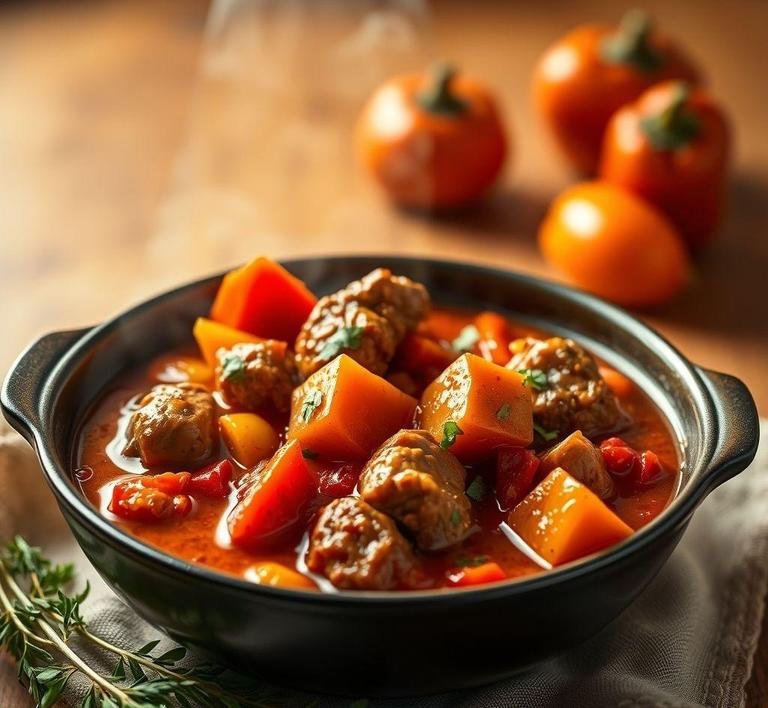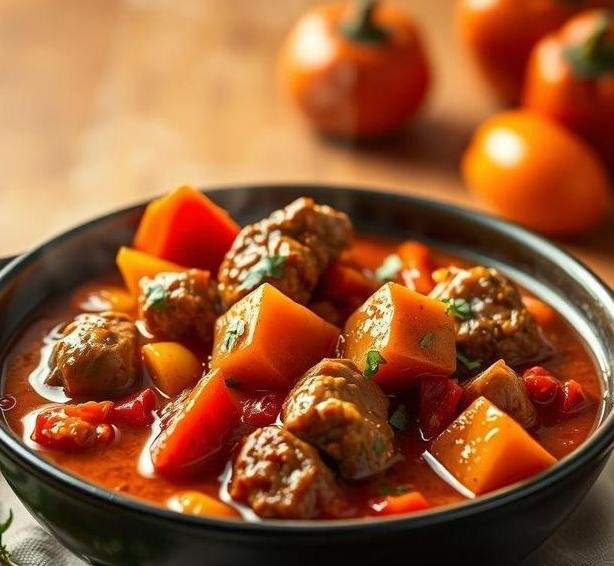Mary Berry’s Hungarian Goulash is a comforting, hearty dish that blends the rich flavors of tender beef, paprika, and vegetables into a savory, slow-cooked stew. While goulash is often associated with Hungarian cuisine, each country has its own interpretation. Mary Berry, famed for her approachable yet refined cooking style, brings her own twist to this classic. Her version of Hungarian Goulash remains true to its roots but is simplified for home cooks without sacrificing any of the depth of flavor.
This goulash is a flavorful, slow-cooked dish, where tender chunks of beef simmer in a fragrant broth enriched with paprika, garlic, onions, and a variety of vegetables. The combination of ingredients results in a comforting, slightly spicy dish with a rich, savory sauce that’s perfect for colder months.
What sets Mary Berry’s recipe apart is her emphasis on balance-balancing the heat from the paprika with the sweetness of bell peppers and the earthiness of root vegetables. It’s the kind of dish that not only nourishes the body but also offers a bit of nostalgia, taking you on a culinary journey to the heart of Hungary.
Mary Berry’s Hungarian Goulash Recipe
Ingredients Needed

Mary Berry’s Hungarian Goulash recipe calls for simple yet flavorful ingredients, most of which you can easily find at your local grocery store. Here’s a rundown of the essentials:
- Beef (Chuck or Stewing Beef): The star of this dish. Tender cuts of beef that break down beautifully during cooking are essential to goulash. Chuck or stewing beef works best because it becomes tender and flavorful after slow cooking.
- Onions: A good goulash starts with onions, which are sautéed to provide a sweet and savory base for the dish. Mary Berry often recommends using a medium-sized yellow onion.
- Garlic: Fresh garlic adds an aromatic depth to the goulash, infusing the sauce with a fragrant, almost sweet note. It’s best to finely chop or crush it to release all the flavors.
- Bell Peppers: Traditional Hungarian goulash often includes bell peppers for sweetness. Mary Berry opts for red peppers to bring a rich color and vibrant flavor to the stew.
- Carrots and Potatoes: Root vegetables like carrots and potatoes add bulk to the dish, making it filling and wholesome. They also absorb the flavors of the broth, making each bite more satisfying.
- Paprika (Sweet and Smoked): Paprika is the key ingredient in goulash, and Mary Berry uses both sweet and smoked paprika for an intricate balance of heat and smokiness. Hungarian paprika, known for its deep red color and smoky undertones, is ideal, though regular paprika can be used as a substitute.
- Tomato Purée: Tomato purée adds richness and a slight tanginess, complementing the earthiness of the paprika.
- Beef Stock: A rich, flavorful stock serves as the liquid base, allowing the beef and vegetables to simmer slowly, absorbing all the flavors. Homemade stock is preferable, but store-bought options work as well.
- Bay Leaves and Thyme: These herbs add complexity and earthiness to the dish, with bay leaves contributing a subtle aromatic flavor and thyme providing a slightly minty note.
- Salt and Pepper: Basic seasonings that help balance and enhance the overall flavor profile of the dish.
- Sour Cream (Optional): In some versions, a dollop of sour cream is added to the dish before serving. It helps to mellow out the spice and adds a luxurious creaminess to the goulash.
Equipment Needed
For Mary Berry’s Hungarian Goulash, you’ll need basic kitchen equipment to get started, but having the right tools can make the process smoother. Here’s a list of the key pieces of equipment you’ll need:
- Large Dutch Oven or Heavy-Bottomed Pot: A large, sturdy pot with a tight-fitting lid is ideal for this dish. A Dutch oven allows the beef and vegetables to cook evenly, ensuring that everything is tender and infused with flavor. It’s also perfect for slow cooking.
- Sharp Knife: A good chef’s knife is crucial for chopping the beef, onions, garlic, and vegetables. A sharp blade will make the prep work easier and safer.
- Chopping Board: Having a sturdy, clean chopping board is important for safely preparing all the ingredients.
- Wooden Spoon or Spatula: A wooden spoon is perfect for stirring the goulash without scratching the pot, allowing you to sauté the onions and garlic and stir the stew gently during cooking.
- Ladle: Once the goulash is ready, a ladle is ideal for serving up portions without making a mess.
- Measuring Spoons and Cups: Accurate measurements are important, especially when dealing with spices like paprika. Having these on hand ensures you don’t overdo or underdo the seasonings.
Instructions To Make Mary Berry’s Hungarian Goulash
Step 1: Prepare the Ingredients
Start by prepping your ingredients. Chop the beef into chunks, peel and slice the onions, chop the garlic, and dice the bell peppers, carrots, and potatoes into bite-sized pieces. Measure out your spices, stock, and other ingredients so you have everything ready to go.
Step 2: Brown the Beef
In a large Dutch oven or heavy-bottomed pot, heat some oil over medium-high heat. Once the oil is hot, add the beef chunks in batches to avoid overcrowding the pan. Brown the beef on all sides to develop a rich, caramelized color. This step is essential for building deep flavors. Remove the beef from the pot and set aside.
Step 3: Sauté the Onions and Garlic
In the same pot, add a little more oil if needed and sauté the onions until they become translucent and soft, about 5-6 minutes. Add the garlic and cook for another 1-2 minutes, being careful not to burn it.
Step 4: Add the Paprika and Vegetables
Add both sweet and smoked paprika to the pot and stir to coat the onions and garlic in the spices. This will help release the oils in the paprika, enhancing the flavor. Then, add the chopped bell peppers, carrots, and potatoes, stirring everything together for another minute.
Step 5: Add the Tomato Purée and Stock
Stir in the tomato purée, allowing it to blend into the vegetables and create a slightly thickened base. Pour in the beef stock and bring the mixture to a simmer. Make sure there’s enough liquid to cover the vegetables and beef, adding more stock or water if necessary.
Step 6: Simmer and Slow Cook
Return the browned beef to the pot along with the bay leaves and thyme. Season with salt and pepper. Stir everything together, then cover the pot and reduce the heat to low. Let it simmer gently for 1.5-2 hours, or until the beef is tender and the vegetables are cooked through. Stir occasionally to make sure the stew doesn’t stick to the bottom.
Step 7: Final Adjustments
Once the goulash is done, taste and adjust the seasoning as needed. If you like your goulash a little spicier, feel free to add more paprika or a pinch of chili flakes. If you’re using sour cream, swirl a spoonful into each bowl before serving.
Tips And Tricks
- Use a Cut of Beef That’s Meant for Stewing: Chuck or stewing beef is ideal because it becomes tender and flavorful after slow cooking. Avoid lean cuts, which can dry out and become tough.
- Paprika Matters: Hungarian paprika is preferred for this dish, as it has a distinctive smoky-sweet flavor that regular paprika can’t replicate. If you can’t find it, use a mix of sweet and smoked paprika.
- Slow Cooking Is Key: Don’t rush the cooking process. Allow the stew to simmer slowly, which allows the flavors to deepen and meld together.
- Vegetable Variations: Feel free to add other vegetables like parsnips, celery, or peas to your goulash. They can add a new layer of flavor and texture to the dish.
- Serve with Rustic Bread or Dumplings: Goulash is often served with thick slices of rustic bread or Hungarian dumplings (nokedli) to soak up the rich sauce.
- Make It Ahead: Goulash tastes even better the next day as the flavors continue to develop. It’s perfect for meal prep or to make ahead for a gathering.
Mary Berry’s Hungarian Goulash is the epitome of comfort food. Its tender beef, aromatic spices, and rich, flavorful sauce make it the perfect dish for a family dinner or a special gathering. The slow-cooked stew is easy to prepare but brims with depth, and its simplicity ensures that the ingredients shine through. Whether you enjoy it on a cold evening or as part of a hearty meal, this dish promises to satisfy. Pair it with crusty bread or dumplings, and you’ve got yourself a complete meal that’s sure to impress.
Easy Recipe Variations For Mary Berry’s Hungarian Goulash

Mary Berry’s Hungarian Goulash is already a flavorful and hearty dish, rich in paprika and tender beef, with a perfectly balanced depth of flavor. However, there are many ways to put your personal spin on this classic recipe to suit different tastes and preferences. Here are some simple yet creative variations to elevate or personalize the dish:
1. Vegetarian Goulash
For those who prefer a plant-based version, you can replace the beef with hearty vegetables like potatoes, carrots, parsnips, and mushrooms. You can also add some lentils or chickpeas to mimic the richness of meat and create a filling, nutritious dish. Tofu or tempeh are excellent protein alternatives that will soak up the spices and flavors beautifully.
2. Chicken Goulash
For a lighter variation, swap the beef for chicken. Chicken thighs work best as they stay moist and tender during slow cooking, offering a lovely, juicy texture. This variant retains the same warmth and depth of flavor but with a slightly milder, leaner profile. You can also add some cream towards the end of cooking to give the sauce a richer texture.
3. Spicy Goulash
Hungarian goulash is typically mild with a warmth from the paprika, but if you like heat, try adding some chopped fresh chili peppers or a pinch of cayenne pepper to the pot. You can also increase the amount of hot paprika used to give the dish an extra kick. This version will have a noticeable spicy edge that contrasts wonderfully with the sweetness of the paprika and the richness of the beef.
4. Goulash With Smoked Paprika
Smoked paprika adds a subtle, smoky flavor to the goulash. Swap some of the regular paprika for smoked paprika, and the dish will take on a new dimension of flavor. This variation is particularly lovely when paired with a side of crusty bread or over creamy mashed potatoes, as the smoky depth complements the softness of the starches.
5. Goulash With Root Vegetables
To add even more complexity and texture, you can throw in some root vegetables such as swede (rutabaga), turnips, or celeriac along with the onions and peppers. These vegetables add an earthy flavor that balances the sharpness of the paprika and the richness of the beef, creating a wonderfully full-bodied dish.
6. Goulash Soup
If you love a more soup-like consistency, Mary Berry’s goulash can be easily transformed into a hearty, comforting soup. Simply increase the quantity of stock (or water) and add more vegetables like celery and leeks. You can even blend a portion of the soup for a creamier texture. This version is especially popular in colder months and pairs wonderfully with fresh, crusty bread or a dollop of sour cream.
Storing Leftovers
Hungarian goulash is one of those dishes that only gets better after a day or two, making it perfect for leftovers. Here’s how to store it properly to maintain its wonderful flavors:
1. Refrigeration
Allow the goulash to cool down to room temperature before refrigerating it. This helps prevent condensation inside the storage container, which can affect the dish’s texture. Store the goulash in an airtight container and place it in the fridge, where it will keep for about 3-4 days. The flavors will continue to meld together, giving the goulash an even richer taste after a day or two.
2. Freezing
If you’ve made a larger batch and don’t plan on finishing the leftovers within a few days, freezing goulash is a fantastic option. Transfer the cooled goulash into a freezer-safe container or a resealable plastic bag (flattened to remove excess air) for storage. It will last up to 3 months in the freezer. When reheating, let it thaw overnight in the fridge, or gently reheat it in a pot, adding a splash of water or stock if needed to restore its original consistency.
3. Reheating Tips
Reheating goulash can sometimes result in it becoming too thick or dry. To restore its original texture, add a bit of extra stock or water while reheating. For best results, reheat the goulash gently on low heat, stirring occasionally, to avoid burning or overcooking the beef. Alternatively, you can use the microwave, but be sure to stir it halfway through to ensure even heating.
What To Eat With Mary Berry’s Hungarian Goulash?
Hungarian goulash is a rich, comforting dish, and finding the right sides to accompany it can elevate your meal to the next level. Below are some delicious side dishes that pair wonderfully with the goulash, enhancing its flavors and creating a complete, satisfying meal:
1. Crusty Bread
A hearty, rustic bread, like a sourdough or a crusty baguette, is ideal for mopping up the thick, flavorful sauce of the goulash. The bread will soak up all the juices and provide a satisfying contrast to the tender beef and soft vegetables. A warm loaf of bread served on the side is both simple and divine.
2. Creamy Mashed Potatoes
For an indulgent option, creamy mashed potatoes are an excellent choice. The smooth, buttery potatoes act as a soft counterpoint to the robust, spiced goulash. If you’re feeling extra fancy, you can infuse the mashed potatoes with garlic or horseradish for an added layer of flavor that complements the dish.
3. Spaetzle Or Dumplings
For a more traditional Hungarian side, serve your goulash with spaetzle-small, egg-based dumplings that are the perfect vehicle for absorbing the rich sauce. Alternatively, serve the goulash with soft bread dumplings or Hungarian nokedli. These starchy sides are filling and provide a lovely texture contrast to the saucy goulash.
4. Steamed Vegetables
Steamed vegetables like green beans, peas, or roasted carrots offer a light, fresh contrast to the heaviness of the goulash. The slight sweetness and crunchiness of these vegetables balance the richness of the beef and paprika sauce, adding a touch of brightness to the meal.
5. Cabbage Slaw
A tangy, crisp cabbage slaw is a wonderful side to serve alongside goulash. The acidity of the slaw cuts through the richness of the goulash, providing a refreshing contrast. You can make a simple slaw with cabbage, vinegar, a touch of sugar, and some caraway seeds for an added hint of spice.
6. Pickles
A side of tangy pickles or pickled vegetables is another great accompaniment, as the acidity and sharpness contrast with the rich, hearty flavors of the goulash. A traditional Hungarian side dish would be pickled cucumbers, but you can also opt for pickled peppers or even a mix of different pickled vegetables.
Conclusion
Mary Berry’s Hungarian Goulash is a comforting, flavorful dish that brings the warmth of Hungarian cuisine right to your table. Its hearty blend of beef, paprika, and vegetables offers a rich, savory experience that can be customized in numerous ways to suit different tastes or dietary preferences. From transforming it into a vegetarian or chicken goulash to spicing it up with smoked paprika or extra chili, the variations are endless.
Storing leftovers is a breeze, and goulash often tastes even better after a day or two, making it an ideal meal for meal prep. Paired with the right sides-whether it’s crusty bread, creamy mashed potatoes, or tangy pickles-you’ll have a meal that’s satisfying, flavorful, and comforting every time you serve it. With these easy-to-implement variations and pairing ideas, Mary Berry’s Hungarian Goulash is sure to become a regular in your recipe rotation!
FAQs
What Ingredients Are Needed For Mary Berry’s Hungarian Goulash?
Mary Berry’s Hungarian Goulash recipe typically requires beef stewing steak, onions, garlic, paprika (a key ingredient for authentic flavor), tomatoes, beef stock, potatoes, and carrots. Additionally, a touch of oil, salt, and pepper is used to season the dish. It’s important to use good-quality paprika, preferably sweet or smoked, for a more genuine taste.
How Long Does It Take To Make Mary Berry’s Hungarian Goulash?
The cooking time for Mary Berry’s Hungarian Goulash is approximately 2 to 2.5 hours, which includes the time for slow simmering to tenderize the beef and meld the flavors. The preparation itself is quick, usually taking about 20-30 minutes to chop vegetables and brown the meat before it goes into a low-heat simmer.
Can I Make Mary Berry’s Hungarian Goulash In Advance?
Yes, Mary Berry’s Hungarian Goulash can be made in advance. In fact, the flavors improve if it is allowed to rest overnight in the refrigerator. To reheat, simply warm it on the stove over low heat, adding a little more stock or water if needed to adjust the consistency.


